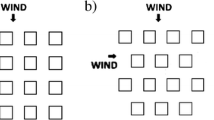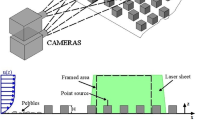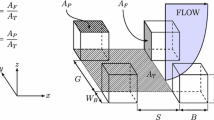Abstract
We conduct wind-tunnel experiments on three different uniform roughness arrays composed of sparsely distributed rectangular cylinders for the estimation of surface parameters. Roughness parameters such as the roughness length z 0 and zero-plane displacement d are extracted using a best-fit approximation of the measured wind velocity. We also perform a large-eddy simulation (LES) to confirm that four sampling points are sufficient to surrogate a space average above the canopy layer of the sparse roughness arrays. We propose a new morphological model from a systematic analysis of experimental data on the arrays. The friction velocity predicted by the proposed model agrees well with the peak value of the measured Reynolds shear stress \({(-\left<\overline{u'w'}\right>)^{0.5}}\). The proposed model is further validated in an additional wind-tunnel experiment conducted on a scaled configuration of a real urban area exposed to four wind directions. The proposed model is found to perform very well particularly in the estimation of the friction velocity, readily leading to a better estimation of turbulence, which is essential for an accurate prediction of pollutant dispersion.
Similar content being viewed by others
References
Bentham T, Britter R (2003) Spatially averaged flow within obstacle arrays. Atmos Environ 37(15): 2037–2043
Britter R, Hanna S (2003) Flow and dispersion in urban areas. Annu Rev Fluid Mech 35(1): 469–496
Cheng H, Castro I (2002a) Near wall flow development after a step change in surface roughness. Boundary-Layer Meteorol 105(3): 411–432
Cheng H, Castro I (2002b) Near wall flow over urban-like roughness. Boundary-Layer Meteorol 104(2): 229–259
Christen A, Rotach M, Vogt R (2009) The budget of turbulent kinetic energy in the urban roughness sublayer. Boundary-Layer Meteorol 131(2): 193–222
Cionco RM (1965) A mathematical model for air flow in a vegetative canopy. J Appl Meteorol 4(4): 517–522
Coceal O, Thomas T, Castro I, Belcher S (2006) Mean flow and turbulence statistics over groups of urban-like cubical obstacles. Boundary-Layer Meteorol 121(3): 491–519
Coceal O, Thomas T, Belcher S (2007) Spatial variability of flow statistics within regular building arrays. Boundary-Layer Meteorol 125(3): 537–552
Counihan J (1971) Wind tunnel determination of the roughness length as a function of the fetch and the roughness density of three-dimensional roughness elements. Atmos Environ (1967) 5(8): 637–642
Grimmond C, Oke T (1999) Aerodynamic properties of urban areas derived from analysis of surface form. J Appl Meteorol 38(9): 1262–1292
Hagishima A, Tanimoto J, Nagayama K, Meno S (2009) Aerodynamic parameters of regular arrays of rectangular blocks with various geometries. Boundary-Layer Meteorol 132(2): 315–337
Hanna S, Britter R (2002) Wind flow and vapor cloud dispersion at industrial and urban sites. CCPS, New York, p 208
Hanna S, Tehranian S, Carissimo B, Macdonald R, Lohner R (2002) Comparisons of model simulations with observations of mean flow and turbulence within simple obstacle arrays. Atmos Environ 36(32): 5067–5079
Hanna S, Brown M, Camelli F, Chan S, Coirier W, Hansen O, Huber A, Kim S, Reynolds R (2006) Detailed simulations of atmospheric flow and dispersion in downtown Manhattan. Bull Am Meteorol Soc 87: 1713–1726
Inagaki A, Kanda M (2008) Turbulent flow similarity over an array of cubes in near-neutrally stratified atmospheric flow. J Fluid Mech 615: 101–120
Iyengar AKS, Farell C (2001) Experimental issues in atmospheric boundary layer simulations: roughness length and integral length scale determination. J Wind Eng Ind Aerodyn 89: 1059–1080
Jackson PS (1981) On the displacement height in the logarithmic velocity profile. J Fluid Mech 111: 15–25
Jiménez J (2004) Turbulent flows over rough walls. Annu Rev Fluid Mech 36(1): 173–196
Kastner-Klein P, Rotach M (2004) Mean flow and turbulence characteristics in an urban roughness sublayer. Boundary-Layer Meteorol 111(1): 55–84
Lettau H (1969) Note on aerodynamic roughness parameter estimation on the basis of roughness element description. J Appl Meteorol 8: 828–832
Macdonald R (2000) Modelling the mean velocity profile in the urban canopy layer. Boundary-Layer Meteorol 97(1): 25–45
Macdonald R, Griffiths R, Hall D (1998) An improved method for the estimation of surface roughness of obstacle arrays. Atmos Environ 32(11): 1857–1864
Macdonald R, Carter S, Slawson P (2000) Measurements of mean velocity and turbulence statistics in simple obstacle array at 1:200 scale. Thermal Fluids Report 2000–1, University of Waterloo, Canada, 130 pp
Macdonald RW, Carter Schofield S, Slawson PR (2002) Physical modelling of urban roughness using arrays of regular roughness elements. Water Air Soil Pollut Focus 2(5): 541–554
Martilli A (2009) On the derivation of input parameters for urban canopy models from urban morphological datasets. Boundary-Layer Meteorol 130(2): 301–306
McDermott R, McGrattan K, Hostikka S, Floyd J (2009) Fire dynamics simulator (version 5) technical reference guide volume 2: verification. National Institute of Standards and Technology, 75 pp
McGrattan K, Hostikka S, Floyd J, Baum H, Rehm R, Mell W, McDermott R (2009a) Fire dynamics simulator (version 5) technical reference guide volume 1: mathematical model. National Institute of Standards and Technology, 108 pp
McGrattan K, Hostikka S, Floyd J, McDermott R (2009b) Fire dynamics simulator (version 5) technical reference guide volume 3: validation. National Institute of Standards and Technology, 298 pp
Petersen R (1997) A wind tunnel evaluation of methods for estimating surface roughness length at industrial facilities. Atmos Environ 31(1): 45–57
Ploss A, Castro I, Cheng H (2000) The surface region of rough wall boundary layers. In: Dopazo C (ed) Advances in turbulence VIII. International Center for Numerical Methods in Engineering, pp 455–459
Raupach MR, Thom AS, Edwards I (1980) A wind-tunnel study of turbulent flow close to regularly arrayed rough surfaces. Boundary-Layer Meteorol 18(4): 373–397
Raupach MR, Coppin PA, Legg BJ (1986) Experiments on scalar dispersion within a model plant canopy, Part I: the turbulence structure. Boundary-Layer Meteorol 35(1): 21–52
Rotach M (2001) Simulation of urban-scale dispersion using a Lagrangian stochastic dispersion model. Boundary-Layer Meteorol 99(3): 379–410
Roth M (2000) Review of atmospheric turbulence over cities. Q J Roy Meteorol Soc 126(564): 941–990
Santiago JL, Martilli A (2010) A dynamic urban canopy parameterization for mesoscale models based on computational fluid dynamics Reynolds-averaged Navier-Stokes microscale simulations. Boundary-Layer Meteorol 137(3): 417–439
Schlichting H, Gersten K (2000) Boundary-layer theory, 8th edn. Springer, Germany, p 799
Shah KB (1998) Large eddy simulations of flow past a cubic obstacle. PhD thesis, Stanford University, 212 pp
Snyder WH, Castro IP (2002) The critical Reynolds number for rough-wall boundary layers. J Wind Eng Ind Aerodyn 90(1): 41–54
Stull R (1988) An introduction to boundary layer meteorology. Kluwer Academic Publisher, The Netherlands, p 666
Tamura T (2008) Towards practical use of LES in wind engineering. J Wind Eng Ind Aerodyn 96(10–11): 1451–1471
Theurer W (1993) Dispersion of ground-level emissions in complex built-up areas. PhD thesis, Doctoral thesis, Department of Architecture, University of Karlsruhe, Germany
Theurer W, Baechlin W, Plate EJ (1992) Model study of the development of boundary layers above urban areas. J Wind Eng Ind Aerodyn 41(1–3): 437–448
Visual Numerics Inc.: (1997) IMSL STAT/LIBRARY: Fortran subroutines for statistical applications. Visual Numerics Inc., Texas
Werner H, Wengle H (1992) Large-eddy simulation of turbulent flow over and around a cube in a plate channel. In: Turbulent shear flows: selected papers from the eighth international symposium on turbulent shear flows, vol 8. Springer-Verlag, Berlin, pp 155–168
Author information
Authors and Affiliations
Corresponding author
Rights and permissions
About this article
Cite this article
Kim, BG., Lee, C., Joo, S. et al. Estimation of Roughness Parameters Within Sparse Urban-Like Obstacle Arrays. Boundary-Layer Meteorol 139, 457–485 (2011). https://doi.org/10.1007/s10546-011-9590-8
Received:
Accepted:
Published:
Issue Date:
DOI: https://doi.org/10.1007/s10546-011-9590-8




